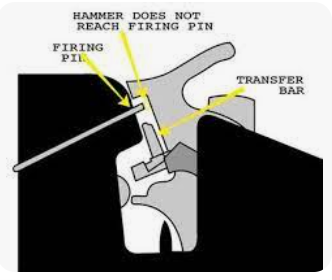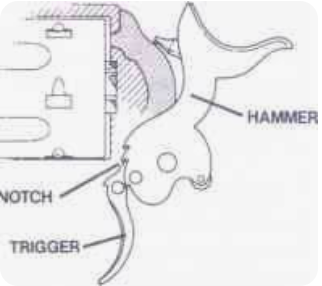The main problem with these threads are that 'half cock' is a misnomer when used to describe 'half-open-bolt'. It's in the same mentality ballpark as calling a rifle with a pistol grip, a machine-gun.
Semantics but if you call petrol 'fuel', and you call diesel 'fuel', sooner or later this can lead to difficulties with your vehicle starting, rough running, misfires, smoke and failure to run.
If you call 'half-open-bolt' 'half-cock', and you call a half cocked hammer 'half-cock' sooner or later this can lead to the uninitiated believing that a 'half-open-bolt' is a safety design equivalent to 'half-cock' when in fact they are different things that apply to usually different rifles.
It's a dumbed down over simplification that can lead to trouble.
Half cock is a hammer or striker position that is not full cock ready to fire, but not with the firing pin resting on the primer either. It is a feature of most exposed hammer actions and many of the older bolt actions including the SMLE. It is achieved after chambering a round by taking up the tension on the striker or hammer, squeezing the trigger and gently lowering the hammer or striker to the half-cock position. The hammer or striker is then pulled back to full-cock when the shooter decides they are ready to fire.
As per the picture above, on some rifles such the Rossi pomba or H&R Handi rifle, hammer-down (in lieu of half-cock) is a relatively safe state, as there is a transfer bar between the hammer and the firing pin that drops away when the hammer is de-cocked, so the hammer rests off the firing pin. On some lever actions and other older designs there is only a small leaf spring engaging with the hammer to hold it a half-cock.
The picture below is of a revolver hammer, but it shows the general principle of exposed hammer half-cock without transfer bar.
If a firearm with exposed hammer or striker is dropped and it lands hammer first with a round in the chamber, there is a chance that round will discharge, if the firearm has the transfer bar system, that chance is miniscule, it has happened plenty of times to exposed hammer firearms that did not have the transfer bar system.
There have also been occasions where a firearm has discharged under the following circumstances (this is not the full list):
-when the safety wasn't on and there was a round in the chamber
-when they safety was on and there was a round in the chamber
-the person holding the firearm thought the safety was on and there was a round in the chamber.
-the person holding the firearm didn't know if the safety was on so they pulled the trigger to check if the safety was on and there was a round in the chamber.
-the bolt was half closed and got bumped to 3-4 closed and the trigger was pulled and there was a round in the chamber.
-the bolt got bumped closed while someone had their finger on the trigger and there was a round in the chamber.
-the barrel was really hot and there was a round in the chamber.
-the person holding the firearm deliberately squeezed the trigger while aiming at a target they wanted to shoot and there was a round in the chamber.
The point I am trying to make with the list above is that if there is a round in the chamber, there is some chance of discharge, the only way around that is not putting a round in the chamber, ever. But that would make the firearm pointless, so we manage that risk if we put a round in the chamber.
A safety catch is one mechanism that can help us with this, but it is naïve to view it as 100% reliable, it is at best, only as good as the operator, and from there we work downward to outright dangerous.
There are many different safety designs with different pros and cons and different levels of effectiveness, so no outright statement can apply to the reliability or efficacy of the safety catch in general.
Neither can any outright statement apply to the efficacy of the half-open-bolt principle as again it depends on the type and condition of the bolt.
The best you can do is fully understand your own firearm, how the safety works, how the cocking mechanism works and what is best in your circumstances, if there is lack of enlightenment or if there is doubt, don't hunt with 'one up the spout'.
Welcome guest, is this your first visit? Create Account now to join.
Welcome to the NZ Hunting and Shooting Forums.
Search Forums
User Tag List
+ Reply to Thread
Results 1 to 15 of 133
Thread: Half cock or safety
Hybrid View
-
26-07-2023, 11:44 PM #1Member

- Join Date
- Sep 2013
- Location
- Wairarapa
- Posts
- 1,396
Similar Threads
-
T3 Half- cock issue
By ex-NZFS in forum Firearm SafetyReplies: 45Last Post: 12-04-2016, 11:08 PM -
T3 Half Cock Methods
By Tentman in forum Firearms, Optics and AccessoriesReplies: 17Last Post: 30-11-2014, 09:42 AM -
remington 700 half-cock
By scottrods in forum Firearms, Optics and AccessoriesReplies: 1Last Post: 23-02-2012, 09:32 PM
Tags for this Thread
Welcome to NZ Hunting and Shooting Forums! We see you're new here, or arn't logged in. Create an account, and Login for full access including our FREE BUY and SELL section Register NOW!!





 290Likes
290Likes LinkBack URL
LinkBack URL About LinkBacks
About LinkBacks





 Reply With Quote
Reply With Quote


Bookmarks